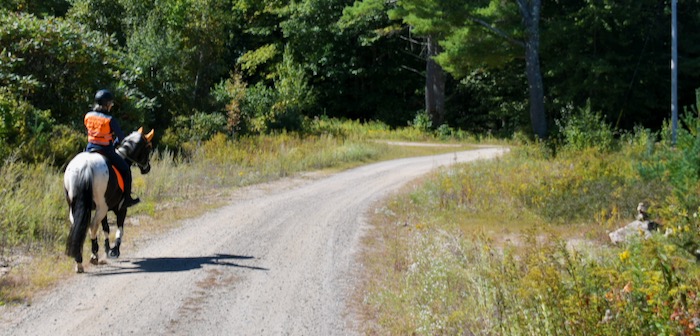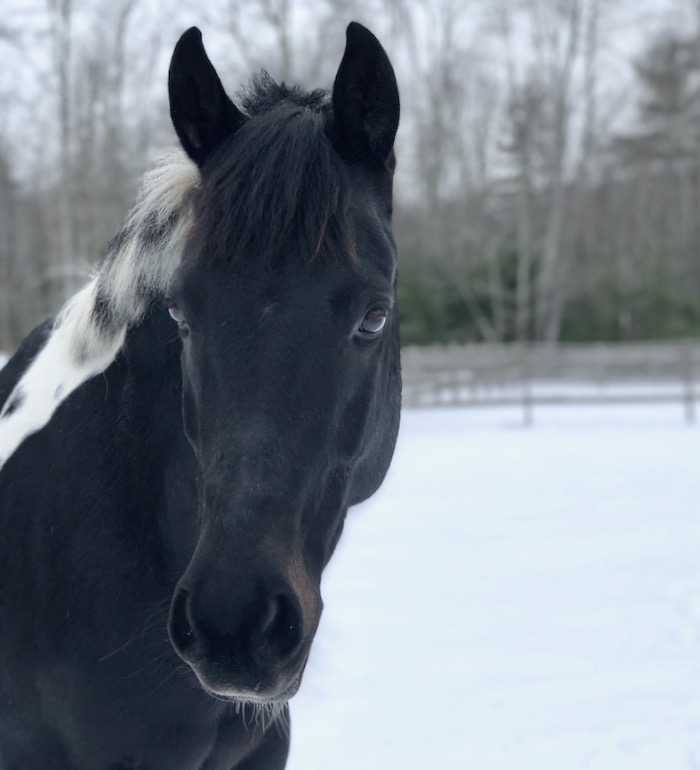The nature of science is that we build on what we know. Sometimes we have to discard ideas when more solid information comes along. Sometimes what has been researched is very, very complex, but the popular press gets hold of it, someone writes a best-selling book inflating it into a whole philosophy, and a little piece of information becomes ingrained into our communal psyche. That’s what happened with the left brain/right brain theory of learning. Over and over it’s been disproven, and yet we still tell ourselves that we’re one sort of person or another and even base teaching methods on it. Yes, we have innate personalities, but it’s not because one side of the brain is dominant. Here’s a good article about this, and here’s some research.
But what does this have to do with horses? Somewhere along the line someone must have read about horse brain anatomy and somehow the facts got skewed so that now there’s a firmly held belief that is detrimental to training. This misinformation taps into that false theory about right brain/left brain independence. This myth claims that one side of the horse’s brain cannot talk to the other. That what a horse sees out of one eye appears so unique to the horse that when the same thing is viewed by the other, it’s as if the horse is seeing it for the first time. This is not true.
The brain has two hemispheres. They communicate rapidly to each other via a ropey-looking structure called the Corpus callosum. It is only when that is severed (surgery or injury) that the two hemispheres act independently (if the individual survives.) Otherwise, the brain’s workings are smoothly integrated. Horses have large, intact, and fully functioning Corpus callosum. This has been proven with high field MRI, and also with a behavioral study. I haven’t been able to find the origin of the myth that the horse either doesn’t have a Corpus callosum, or that it is negligible in size, but that idea is out there. It’s on the American Quarter Horse Association website which states that the horse’s brain is “missing the corpus callosum.” One blog says, “change sides, train a new horse.” This just isn’t so, and if you base training methods on it, you’re doing you and your horse a disservice.
Here Tonka is eyeballing a decorative cairn along the road.

On the way back he eyeballed it again. Not because he thought it was a different pile of rocks, but because he was still interested in what it was. By the time we rode by the cairn on the way home the light had shifted. He knew it was the same pile of rocks, but it deserved a second look. (How a horse tilts its head, how it sees in sunlight and dark does come into play here. Read this about horse vision.) Rocks balancing on each other like that is out of the ordinary. Horses often worry about such things. (Delve into more in the spooking category on this blog.) Because I know that Tonka’s (very intelligent) brain is processing all of this, all he needed was for me to be relaxed, let him think about it, and we were able to ride by without drama.

Your horse’s brain is a miraculous organ. Brain science is still in its infancy. But we do know that the horse has all of its parts intact! And that your horse is fully capable of understanding and thinking through what they see in the world around them. Trust in that intelligence.


Another interesting blog. Thanks. I have always heard that one-sided brain thing and didn’t have any reason to doubt it. Makes more sense what you wrote about it.
Makes you think about how much we accept without critical thinking! 🙂
Glad to know that the horse has a sensible and smoothly working brain.
They do like to think, and pause to inspect novelty.
Only when they are shoved around and forced too much do they shut down. anyway that’s my observation.
Karen Pryor
Great article, Terry. But how do you explain the fact we have to train horses on “both sides” as if they are seeing the action/activity/stimulus for the first time?
This explains that we don’t have to do that. They are perfectly aware of the world around them, both sides. At the same time. If your horse spooks coming back around, it might be that the shadows, the movement, etc. have changed. It’s not that they don’t know that those objects aren’t there.
Hi Terry. Great article. Anyone studying equine anatomy, or anyone lucky enough to be able to dissect an equine brain, will indeed find a fully functioning corpus callosum. Information received by the brain through all five of the horses senses will be fully processed by its cognitive functions. However, because horses do not think in words, when taught a concept, such as how to place its feet on a curved line to create a circle, the horse will not transfer that information from one side of the brain to the other. The concept must be taught in both directions. Maybe that is where the confusion came from…
Lucky you to have done a dissection! I don’t quite understand your point. Do animals need words to learn how to travel in different directions? The equivalent of human language? I don’t think so. I wouldn’t use the term “concept” to describe a horse traveling on a circle. “Concept” training for me is more about the intangible, for examples, targeting a specific learned shape; selecting “bigger” from “smaller.” I’d be interested in reading more research about what the corpus callosum is and isn’t capable of. If you have links, do send!
It’s Humans with their chauvinism that shows me lack of intelligence.. I Find horses are much more intelligent then what they are given credit for . I train my horses on both sides with no issues , just like people they have a more predominant side …. So maybe they are not so much left/right brained but the behaviors associated with such ( put in equine behaviors) I find is very interesting and works .
Hello Terry, I am very intrigued by your article. I also always thought the horse was very one-sided. May I ask where you got your information from (scientific articles?) I am writing a small piece about the subject.
Kind regards 🙂
Hi Anna, If you click on the highlighted words in the article, they’re live links that will send you to the research.
Knowledge is about nuance and shade of grey, not the black and white of simplified shorthand notions that become solidified into so called fact. How the brain works is different in all creatures and influenced in large part by the environment the organism lives and developed in. The roots of the “left brain/right brain” ideas is explored in great detail by Ian McGillcrest in his book “The master and his emissary” (layman’s shorter book “ways of attending”). Every organism needs to be able to focus to eat (think of a bird picking a seed from gravel) and at the same time be aware of the larger environment so as not be eaten itself while intently focusing. The left hemisphere focuses intently while the right hemisphere is open to new information and awareness of the larger environment. The fact that horses are prey animals is an environmental factor that probably influences a left eye/right hemisphere bias to new stimuli in the environment. Future responses to the same or similar stimuli are internalized by communication between the two hemispheres, but I presume that the net effect is a prey response, as opposed to the more complex human interpretation of environmental stimuli. So, at the end of this nerdy discussion it is probably good to introduce new stuff to a horse’s left eye, followed by the right eye. When walking my horse around new stuff I generally take this approach.
Thank you for weighing in (and the coffee!) The perceptual world is extremely complex! Have you read “The Immense World” by Ed Yong?. Each species has a different way of perceiving its environment. Also, “Horse Brain, Human Brain” gets into how horses process images differently, so that a view from a new direction might have an object look like a different thing, until the horse gathers more perceptual info. And then there’s the really exciting research into how myelin connects the brain. That’s transforming the idea about distinct regions. I keep an open mind 🙂 about the brain.
He Terry,
I’m an old timer, and even 60 years ago, people were saying that a horse would be afraid of something on one side and not the other. I had no reason to doubt it, but have wondered about it through the years. Well-known, professional trainers, will say, “get him to use the thinking side of the brain”. Don’t both sides of the brain think? They want us to believe that there is a flight side and a calmer thinking side.